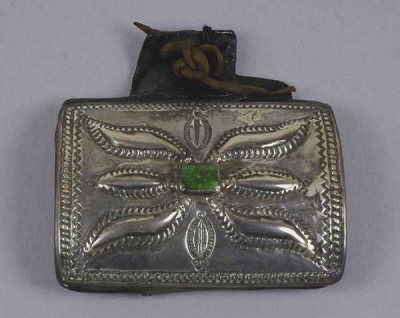Wrist guard (1951.6.74)
 USAWrist guard from the USA, Americas. Collector not known. Given to the Museum by the Wellcome Historical Medical Museum in 1951.
USAWrist guard from the USA, Americas. Collector not known. Given to the Museum by the Wellcome Historical Medical Museum in 1951.
A wrist guards, known as ketoh, was worn by a Navajo archer of Arizona, to protect the wrist of his bow hand from being caught by the string when shooting. Most functional ketoh were made of just leather but this example has been covered with a decorative layer of silver plate, with a stamped design and set with a single green turquoise stone.
As sheep farming replaced hunting within the Navajo economy in the late 19th century, ketoh became pieces of ornamental male jewellery. Objects such as this thus acquired great value in the Navajo economy, and represented a form of 'movable wealth' that a man could keep on his person.
By the early decades of the 20th century, Navajo silverwork with turquoise inlay had become famous within the Native American art market. The Navajo have maintained a consistently high quality of workmanship ever since, expanding the scale of their handicrafts industry enormously and elevating their silverwork into a global commodity.




